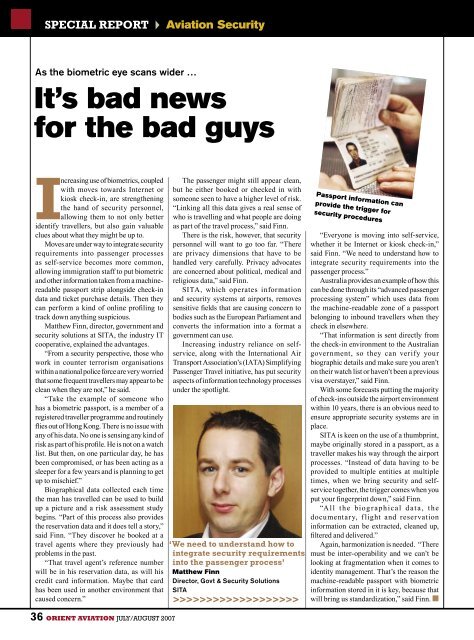Malaysia Airlines - Orient Aviation
Malaysia Airlines - Orient Aviation
Malaysia Airlines - Orient Aviation
You also want an ePaper? Increase the reach of your titles
YUMPU automatically turns print PDFs into web optimized ePapers that Google loves.
SPECIAL REPORT<br />
<strong>Aviation</strong> Security<br />
As the biometric eye scans wider …<br />
It’s bad news<br />
for the bad guys<br />
Increasing use of biometrics, coupled<br />
with moves towards Internet or<br />
kiosk check-in, are strengthening<br />
the hand of security personnel,<br />
allowing them to not only better<br />
identify travellers, but also gain valuable<br />
clues about what they might be up to.<br />
Moves are under way to integrate security<br />
requirements into passenger processes<br />
as self-service becomes more common,<br />
allowing immigration staff to put biometric<br />
and other information taken from a machinereadable<br />
passport strip alongside check-in<br />
data and ticket purchase details. Then they<br />
can perform a kind of online profiling to<br />
track down anything suspicious.<br />
Matthew Finn, director, government and<br />
security solutions at SITA, the industry IT<br />
cooperative, explained the advantages.<br />
“From a security perspective, those who<br />
work in counter terrorism organisations<br />
within a national police force are very worried<br />
that some frequent travellers may appear to be<br />
clean when they are not,” he said.<br />
“Take the example of someone who<br />
has a biometric passport, is a member of a<br />
registered traveller programme and routinely<br />
flies out of Hong Kong. There is no issue with<br />
any of his data. No one is sensing any kind of<br />
risk as part of his profile. He is not on a watch<br />
list. But then, on one particular day, he has<br />
been compromised, or has been acting as a<br />
sleeper for a few years and is planning to get<br />
up to mischief.”<br />
Biographical data collected each time<br />
the man has travelled can be used to build<br />
up a picture and a risk assessment study<br />
begins. “Part of this process also provides<br />
the reservation data and it does tell a story,”<br />
said Finn. “They discover he booked at a<br />
travel agents where they previously had<br />
problems in the past.<br />
“That travel agent’s reference number<br />
will be in his reservation data, as will his<br />
credit card information. Maybe that card<br />
has been used in another environment that<br />
caused concern.”<br />
The passenger might still appear clean,<br />
but he either booked or checked in with<br />
someone seen to have a higher level of risk.<br />
“Linking all this data gives a real sense of<br />
who is travelling and what people are doing<br />
as part of the travel process,” said Finn.<br />
There is the risk, however, that security<br />
personnel will want to go too far. “There<br />
are privacy dimensions that have to be<br />
handled very carefully. Privacy advocates<br />
are concerned about political, medical and<br />
religious data,” said Finn.<br />
SITA, which operates information<br />
and security systems at airports, removes<br />
sensitive fields that are causing concern to<br />
bodies such as the European Parliament and<br />
converts the information into a format a<br />
government can use.<br />
Increasing industry reliance on selfservice,<br />
along with the International Air<br />
Transport Association’s (IATA) Simplifying<br />
Passenger Travel initiative, has put security<br />
aspects of information technology processes<br />
under the spotlight.<br />
‘We need to understand how to<br />
integrate security requirements<br />
into the passenger process’<br />
Matthew Finn<br />
Director, Govt & Security Solutions<br />
SITA<br />
>>>>>>>>>>>>>>>>>>><br />
Passport information can<br />
provide the trigger for<br />
security procedures<br />
“Everyone is moving into self-service,<br />
whether it be Internet or kiosk check-in,”<br />
said Finn. “We need to understand how to<br />
integrate security requirements into the<br />
passenger process.”<br />
Australia provides an example of how this<br />
can be done through its “advanced passenger<br />
processing system” which uses data from<br />
the machine-readable zone of a passport<br />
belonging to inbound travellers when they<br />
check in elsewhere.<br />
“That information is sent directly from<br />
the check-in environment to the Australian<br />
government, so they can verify your<br />
biographic details and make sure you aren’t<br />
on their watch list or haven’t been a previous<br />
visa overstayer,” said Finn.<br />
With some forecasts putting the majority<br />
of check-ins outside the airport environment<br />
within 10 years, there is an obvious need to<br />
ensure appropriate security systems are in<br />
place.<br />
SITA is keen on the use of a thumbprint,<br />
maybe originally stored in a passport, as a<br />
traveller makes his way through the airport<br />
processes. “Instead of data having to be<br />
provided to multiple entities at multiple<br />
times, when we bring security and selfservice<br />
together, the trigger comes when you<br />
put your fingerprint down,” said Finn.<br />
“A ll t he biog r aph ical d at a , t he<br />
documentary, f light and reservation<br />
information can be extracted, cleaned up,<br />
filtered and delivered.”<br />
Again, harmonization is needed. “There<br />
must be inter-operability and we can’t be<br />
looking at fragmentation when it comes to<br />
identity management. That’s the reason the<br />
machine-readable passport with biometric<br />
information stored in it is key, because that<br />
will bring us standardization,” said Finn.<br />
36 ORIENT AVIATION JULY/AUGUST 2007








![OAMag-V7N4-Cover [Converted] - Orient Aviation](https://img.yumpu.com/48598575/1/190x255/oamag-v7n4-cover-converted-orient-aviation.jpg?quality=85)








